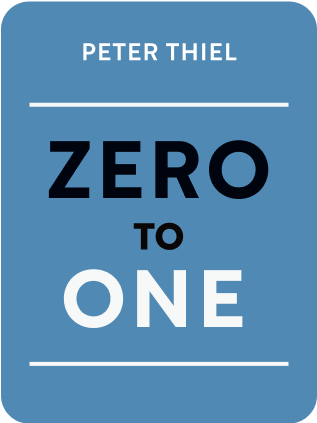

This article is an excerpt from the Shortform summary of "Zero To One" by Peter Thiel. Shortform has the world's best summaries of books you should be reading.
Like this article? Sign up for a free trial here .
What is Zero to One about? What does Zero to One say about building startups and forming monopolies?
Zero to One outlines Peter Thiel’s views on forming successful startups. In Zero to One, startups are only one step of the journey to building a successful business.
What Is Zero to One About?
In Zero to One Peter Thiel, PayPal co-founder and venture capitalist, contends that creating new things is the best way to profit economically, as well as the only path for human progress.
However, technology has stagnated today. Much of what we do repeats or builds on what’s been done before. It’s easier to copy something than to create something new. This moves the world from 1 to n, refining something that already exists. However, creating something entirely new moves us from 0 to 1.
Unless companies create new things, they’ll eventually fail regardless of how profitable they are today. There’s a limit to what we can gain by refining things, a point at which best practices won’t get us any further. We need to break new ground.
The Path of Progress
Progress can be either horizontal or vertical. Horizontal or expansive progress results from duplicating success—going from 1 to n. This kind of progress is easy to envision because it looks a lot like the present. Vertical or intensive (focused) progress requires doing something entirely new—going from 0 to 1. It’s more difficult to envision because we’ve never seen it before.
Continued globalization isn’t feasible without technological progress because the industrialization of more countries will lead to more environmental problems and competition for limited resources. For instance, if China doubles its industrial production without technology improvements, it will double its air pollution. Spreading the practices of developed countries globally will bring devastation rather than wealth. The key to a better future is both imagining and creating the technologies to get us there.
Zero to One Startup Lessons
In Zero to One, Peter Thiel discusses lessons learned from past startups and the tech bubble. Startups consisting of a few people with a common mission are the source of most new technology. But many tech startups today are hobbled by four erroneous lessons drawn from the 1990s dot-com bubble and crash:
- Make incremental advances: Be wary of big visions that drive bubbles. Move forward with small, incremental steps.
- Stay lean and flexible: To stay lean and flexible, don’t tie your hands with planning. Instead, try things and iterate or build on the ones that work.
- Build on the competition: Don’t try to create new markets. Build your business by improving on a product people are already buying from someone else.
- Focus on product, not sales: If you have a good product, it should spread virally without a need for advertising.
Tech startups treat these lessons as sacrosanct, but they actually undermine success, especially big innovations. The opposite of each lesson is more accurate:
- It’s better to be bold than inconsequential.
- A bad plan is better than none.
- Don’t compete: competition destroys profits.
- Sales strategy matters as much as product.
Zero to One on Monopolies and Competition
Monopolies are good for society. In Zero to One, Peter Thiel explains why. While it may seem counterintuitive, they can be more ethical, treat workers with greater consideration, and create more value than companies locked in competition do.
Competitors are caught up in a daily struggle for survival. For instance, with their low margins, restaurants have to do everything possible to minimize expenses—which can include paying minimum wage to employees and putting family members to work for nothing. In survival mode, money is everything.
In contrast, in a monopoly where profits are assured, there’s room to consider other things besides money. For instance, lacking intense competition, Google can give consideration to its workers, its products, and its impact on society.
Monopolies’ bad reputation comes from sometimes earning outsized profits at the expense of society. Certain monopolies corner the market on something that’s needed and jack up the price; customers have no choice but to pay it. This works for the owners in a world where nothing changes, like in the game of Monopoly, where you control as much real estate as you can, but you can’t create new real estate.
In contrast, creative monopolies do good and drive social progress because they operate in a different environment, a dynamic one. Instead of controlling all the options like Monopoly real estate, they create new options. They expand consumers’ choices by creating new categories of things. By adding value, creative monopolies make society better. Zero to One supports the idea of creative monopolies in business.
Monopoly Characteristics
Monopoly businesses with strong future cash flows share several characteristics, the Zero to One book explains.
- Proprietary technology: This may be your greatest possible asset because it makes your product difficult to copy. For example, proprietary technologies used in Google’s search algorithms for aspects such as query autocompletion make the search engine hard to replicate. For proprietary technology to give you a monopolistic edge, it needs to be at least 10 times better in some major way than anything like it. Anything short of a dramatic difference will seem incremental and unimportant.
- Network effects: A network effect is the way additional users improve the value of a product or service for all users. For example, the more your friends use Instagram, the more value you get from being on it too. To generate network effects, your product has to be immediately valuable to its earliest adopters and then grow from there. A network business has to work on a small scale before it can go big—in fact, you have to plan on starting small. Mark Zuckerburg started Facebook by getting just his Harvard classmates to sign up.
- Economies of scale: A monopoly gets stronger as it grows because the fixed costs of creating a new product (like office space and engineering or development) are spread over a greater volume of sales and the cost per unit declines. When starting a business, you should build in the capability of scaling. For example, Twitter enjoys built-in scale: it can keep increasing the number of users without adding customized features.
- Branding: Creating an unassailable brand is integral to having a monopoly. For example, Apple is the most powerful technology brand. Everything from product design (including look and materials), to store design, price, and advertising contributes to an overall impression that Apple products are like no other. Of course, branding alone isn’t enough—you also need substance. Apple’s market dominance is based on superior products backed by an array of proprietary hardware and software technologies.
Zero to One Startup Basics: Key Decisions, Building a Team
When starting a company, it’s important to choose leaders who have the right technical knowledge and whose skills are complementary. Equally important, however, is how well the founders know each other and work together. You also need a structure and clearly defined roles so everyone is aligned to move the organization forward. The Zero to One book outlines major things to consider.
For effective alignment, you must make three decisions:
- Ownership: Who will own the company’s equity. Ownership is typically divided among founders, employees, and investors.
- Possession: Who will run the company day-to-day. It may be a founder/CEO or manager and employees.
- Control: Who will govern the company. A board of directors (usually consisting of founders and investors) maintains control
Selling Your Product
Many Silicon Valley entrepreneurs underestimate the importance of distribution, or the process of selling the product (advertising, sales, marketing, and distribution channels). They often believe their product is so superior it should sell itself: if they build it, customers will come. But understanding distribution and having a plan for it is critical to a company’s success; it should be part of designing your product.
There are two considerations for planning a sales strategy for your product: customer lifetime value and customer acquisition cost.
- Customer lifetime value or CLV is the profit you earn over the course of your relationship with a customer. For example, if you sell low-priced prescription eyeglasses at about $100 a pair and the typical customer needs only a few pairs over her lifetime, the CLV would be only a few hundred dollars.
- The customer acquisition cost is the amount you spend to acquire a customer (your marketing cost divided by the number of customers). You want your customer lifetime value to exceed the amount you spend to get a customer.
Distribution methods range from viral marketing (the cheapest method) to typical marketing, traditional sales, and complex sales (the most costly method).
Generally, the pricier your product is, the more you need to spend on selling it (and the more economic sense it makes to spend the money because you’ll get a big return). In contrast, for a low-priced product like $100 prescription eyeglasses, you’d want an economical method of advertising that wouldn’t eat up the profits from your sales.
Startups fail more often because of poor distribution than because they have a bad product. Getting the right channel to work is the key to a successful business.
A Checklist for Success
The Zero to One book also offers a helpful checklist for startups. In summary, a startup won’t succeed without a business plan that addresses each of the following questions. If your answers are weak, your company will fail—however, with a solid answer for each, you’ll be on your way to having a great business.
- Engineering: Is your technology a significant advance or only incremental improvement?
- Timing: Is this the right time to sell this technology?
- Monopoly: Are you targeting a big share of a small market?
- People: Do you have the right people on your team?
- Distribution: Do you have a plan to sell your product?
- Durability: Will you dominate your market in the next 10 to 20 years?
- Secret: Have you identified a unique opportunity overlooked by everyone else?
Technology of the Future
A Forbes magazine headline once asked: “Will a machine replace you?” But there’s nothing to worry about because computers complement human abilities—they don’t substitute for humans. In the future, the most valuable businesses will be the ones that use technology to help and empower people to do things better, not replace them. Zero to One explains why technology of the future can work for us and why.
Humans can replace or substitute for each other as a result of globalization—for instance, Indian, Chinese, or Mexican workers can replace American workers in manufacturing and customer service.
However, the challenge of the future won’t be labor competition between countries, it will be competition for resources. People in all countries will demand more comforts as their countries develop through globalization and their basic needs are met. The answer to competition for scarce resources is technology that helps people live better.
People and computers are good at different things. People excel at making plans and decisions in complicated situations; they’re not as good at analyzing huge amounts of data. In contrast, computers excel at processing data, but can’t make judgments that are easy for humans.
The different capabilities of humans and computers mean that we can gain more from working with computers than from trading with other people. Other people are like us and do what we do; in contrast, technology helps us do more. People substitute; technology enhances.
Zero to One offers numerous great ideas about building a successful business and planning for the future. You can read Shortform’s full Zero to One summary for a more in-depth explanation.

———End of Preview———
Like what you just read? Read the rest of the world's best summary of Peter Thiel's "Zero To One" at Shortform .
Here's what you'll find in our full Zero To One summary :
- Why some companies genuinely move the world forward when most don't
- How to build a company that becomes a monopoly (and why monopolies aren't bad)
- Silicon Valley secrets to selling products and building rockstar teams






